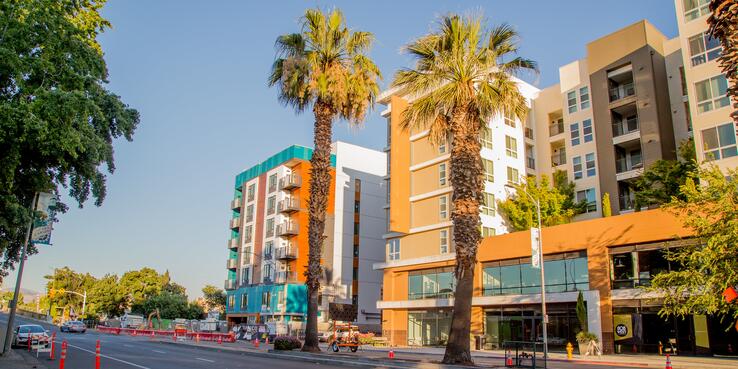On October 10, Governor Newsom signed into law 45 pieces of legislation related to housing, including four SPUR-sponsored bills, two of which received rare signing messages. SPUR not only sponsored the bills but was instrumental in developing them in partnership with a range of stakeholders. The four bills aim to facilitate the construction of low- and middle-income multifamily housing in transit-rich urban areas.
Upzoning Near Transit and Development on Transit Agency Land
The high-profile and historic Senate Bill 79, authored by State Senator Scott Wiener, was signed into law after many rounds of amendments to address concerns and incorporate good-faith feedback throughout the legislative process. It is the culmination of eight years of work on upzoning for transit-oriented housing development, which began with the introduction of Senator Wiener’s SB 827.
This major new law will ensure minimum levels of zoning for multifamily housing in the state’s most frequently served transit-rich urban counties. Mid-rise residential buildings will be allowed on lots zoned for residential, commercial, or mixed-use development within a quarter to half-mile of subway, light rail, bus rapid transit, and busy commuter rail stations.
Additionally, SB 79 authorizes transit agencies to adopt zoning standards for land they own, as long as the standards do not exceed 200% of the zoned capacity otherwise allowed by the law, and at least 50% of the zoning is for residential uses.
In a special signing message, Governor Newsom wrote “for too long, California has poured billions into transit without building the housing density needed for those systems to reach their potential. SB 79 helps change that by focusing more homes near rail stations — boosting ridership, cutting traffic and pollution, lowering household costs, and expanding access to jobs, schools and services.”
The bill’s other co-sponsors are Abundant Housing LA, the Bay Area Council, California YIMBY, Greenbelt Alliance, Inner City Law Center, and Streets for All.
Mixed-Income Housing on Commercial Properties
Described by one of the state’s most prominent land use attorneys as “the most under-the-radar big deal housing bill of the year," Assembly Bill 1050 (Schultz) creates a process for removing private covenants, conditions, and restrictions — including those contained in a reciprocal easement agreement — that prohibit or limit housing development on commercial properties. This new process will help unlock development of mixed-income housing on land that would otherwise be allowable based on local zoning or state law.
In a special signing message, Governor Newsom wrote, in part, “this bill removes outdated barriers that keep underutilized commercial properties from being converted into housing, strengthening our adaptive reuse strategy and accelerating progress toward our statewide housing goals.”
AB 1050 builds on SPUR-sponsored AB 911 (Schiavo), which, when passed in 2023, established the process for removing restrictive covenants in 100% affordable housing developments. It facilitates AB 2011 (Wicks), which passed in 2022 and supports the redevelopment of shopping centers by allowing mixed-income housing on properties zoned for commercial use.
Disclosing Governmental Constraints on Housing Production
Assembly Bill 610 (Alvarez), a good government and transparency law, affects the upcoming seventh cycle of local governments’ housing elements, and all cycles that will follow. It will require housing elements to include a statement disclosing governmental constraints to housing production, specifically each new or amended potential or actual constraint adopted after the due date of the previous housing element and before submittal to the California Department of Housing and Community Development (HCD) of the current draft housing element for the new cycle. It will also require identification of constraints that jurisdictions anticipate adopting within the first three years of the new cycle. The disclosure statement will help both HCD staff and local housing advocates track constraints when evaluating housing elements.
The bill’s other co-sponsors are the California Building Industry Association and the Housing Action Coalition.
Reduced Traffic Impact Fees for Transit-Oriented Development
Senate Bill 358 (Becker) clarifies and improves policy on vehicular traffic impact fees imposed on transit-oriented housing development.
Existing law reduces traffic impact fees for housing developments near transit and other amenities in relation to their walkability and their residents’ comparatively low number of automobile trips. However, there is little guidance for implementation of this statute provision. Cities and counties often ignore the provision because they are allowed to deny reductions in traffic impact fees.
SB 358 expands and specifies the amenities and land uses that qualify nearby housing development for a reduced traffic impact fee. Additionally, the new law requires cities and counties to provide substantial evidence that the proposed development won’t generate fewer vehicle trips than other developments farther from transit and other amenities before they can deny a reduced traffic impact fee.
The bill’s other co-sponsor is Streets for All.
